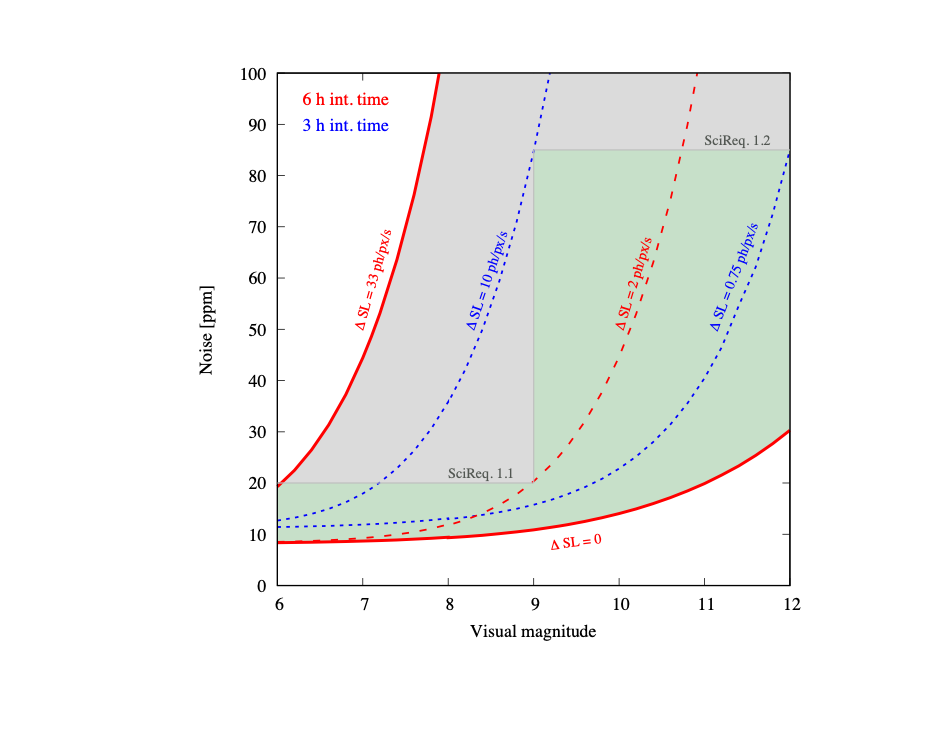Photometric Precision - CHEOPS
Photometric Precision
Designed after the Science Requirements
The requirements on photometric precision are captured in three, top-level Science Requirements, after which CHEOPS was designed. A noise budget was developed during the early phases of the mission to keep track of the photometric precision that could be expected in CHEOPS light curves, given the detailed design of the misison. The budget was based on a very detailed and comprehensive breakdown of individual noise contributions both astronomical (eg. photon noise from the source itself, the zodiacal background, straylight from parasitic illumination of the instrument) and instrument/spacecraft (eg. noise from the analogue electronics chain, jitter noise due to stability of the spacecraft pointing) in origin. A detailed description of the noise budget and how it has been formulated can be found in the CHEOPS mission paper by Benz et al. (2021) and in the CHEOPS Observers Manual. The budget continues to be used during the operational phase, where it forms the basis of the CHEOPS Exposure Time Calculator, which is used by observers to estimate the photometric precision that can be achieved for dfferent observations. The figures below show examples of the 1-sigma photometric precision (in parts per million) that were foreseen pre-launch for a 6-hour and 3-hour on-source integration time (left and right panels respectively), as a function of target magnitude. In both cases the dashed horizontal and vertical lines denote the values (precision and magnitude) that are stipulated for the sizing cases/targets that have been used to define the individual requirements.
Figure 1: Plots illustrating the 1-sigma photometric precision (in parts per million) for CHEOPS for two sizing cases: (a) left hand panel: precision foreseen in a total, on-source integration time of 6 hrs, which is equivalent to the transit duration of a planet with an orbital period of 50 days; (b) right hand panel: precision foreseen after a total on-source integration time of 3 hrs, which is equivalent to the transit duration of a planet with an orbital period of 13 days. In both cases the solid black curve indicates the total precision, where the blue,green and red represent contributions from the instrument, stray light and the photon/shot noise respectively. It can be seen that for the brighter targets (V ≤ 9), the dominant noise source is from the instrument, whereas for the fainter targets (10 ≤ V ≤ 12) initially photon noise from the target itself dominates, and then for fainter stars straylight from the Earth dominates.
- Removed a total of (1) style text-align:center;
- Removed a total of (1) align=center.
Impact of Straylight
The impact of different levels of straylight on photometric performance can be seen below (from Benz et al. (2021)).

Figure 2: Photometric precision (noise) as a function of stellar magnitude (in the V band), based on the pre-launch assessment of the CHEOPS noise budget , based on Figure 1 of Benz et al (2021) Exp Ast. The solid red curve labeled “∆SL = 0” (no stray light contamination) represents the noise floor of CHEOPS in a 6 hour integration time (calculated for an M0 star and representing the best case within science requirements). The solid red curve labeled “∆S L = 33 photons/pixel/s” shows the noise behaviour when the stray light contamination dominates the total noise for all magnitudes (calculated for a G0 star, which represents the worst case within the science requirements). The green region defines the conditions that satisfy the science performance requirements.
- Removed a total of (2) style text-align:center;
in-flight photometric performance
The in-flight photometric performance was first determined during the In-orbit Commissioning Campaign over the period of January - March 2020, and continue to be quantified. Two summaries of the photometric performances that are being achieved, over a range of different timescales and for targets spanning G band magnitudes from approximately Gmag= 6 to approximately Gmag =12, can be found at these two links (a) and (b). Both presentations include comparisons between the measured in-flight performance and predictions made using the Exposure Time Calculator. An assessment of the photometric precision achieved when observing targets that are outside the nominal magnitude range of Gmag 6 - 12 for which CHEOPS has been designed can be found in the presentation found at this link.
Curious to learn more?
Further details on the CHEOPS spacecraft can be found at CHEOPS Consortium Mission website (http://cheops.unibe.ch) and in the references at this link.
This website was last updated on 25 March 2025.








































 Sign in
Sign in
 Science & Technology
Science & Technology